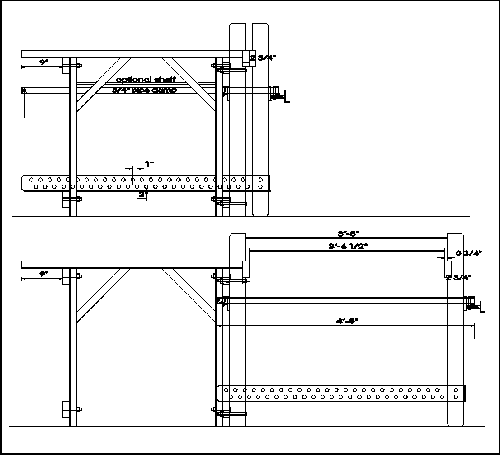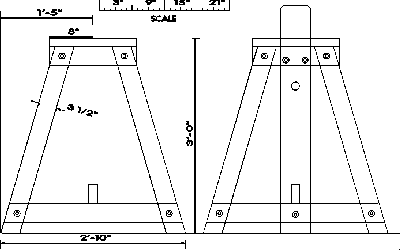

Dentzelbench
Other than the bandsaw and tablesaw, the bench is your largest tool and should be stable, well positioned and anchored. Its combination of wooden carving vice and steel wood workers vise along with the regular use of clamps make up the basic woodcarving shop. Clamps make all the difference in accomplishing glue-up and hold-down tasks, you will become very well acquainted with your clamps, they'll become good old friends. Positioning of the wood so that the grain and carving approach aspect is easy to tackle is highly important, your bench, vice and clamps must be able to accomplish this. Sometimes when cutting the wood to make body boxes or other parts, leaving an chunk of waste wood sticking out, parallel to wood on the other piece being clamped on, helps tremendously as a hold for your clamp. This little protrusion can easily be sawn or chiseled off after the glue-up. Keep gravity on your side when positioning and pounding on your tools or the wood. Remember that the smaller pieces of wood are the most difficult and dangerous to work on, clamp variety will help secure these; always avoid hold pieces in your hand while working on them. This is also true when using the bandsaw, tablesaw, or jointer; the small pieces of wood present the most danger. On the same note, never have your hand or other body part (i.e. lap) near your work put ahead of the chisel in its path. One slip up with this configuration and you can have a very bloody mess to deal with. (I have thrown in a brief FIRST AID SECTION on the last page of this guidebook.)
Take a look at these Dentzelbenches in use, their versatility makes carving all shapes and sizes much easier. If necessary, with a long pipe clamp in the upper part of the sliding jaw and an extra long 2" x 4" guide in the lower part of the jaw, any size of animal will fit in, even the long way. This makes carving two sides of a piece much easier if you are trying to get symmetry or close similarity. For transport, the benches are also break down easily.



Take a close look at the photos on the graphics pages for bench details. Adding a tool shelf just above the pipe that runs under the table is a good accessory. Oiling the bench with the 1/3 varnish, 1/3 boiled linseed oil, 1/3 turpentine mixture is good for looks and longevity. If you make a nice version of this bench and send me a photo (hardcopy or attached .gif or .jpg file to an E-mail), I will put it up on the Dentzelbench graphics page for viewing, with your name by it.